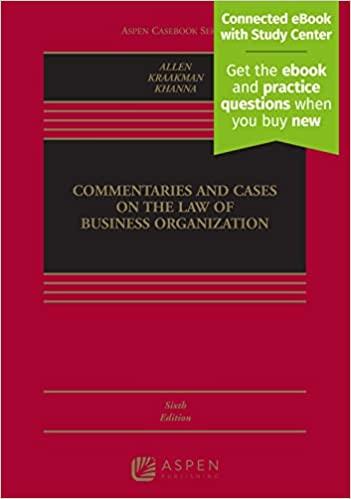Question
Please help and explain, thank you! 23.1. What were some of the key components of early US corporate laws? What was the rationale behind these
Please help and explain, thank you!
23.1. What were some of the key components of early US corporate laws? What was the rationale behind these laws?
23.2. Provide an example of when it would be best to form a partnership, and cite the advantages and disadvantages of doing so.
23.3. Do you think that corporations should have rights similar to those of natural persons? Should any of these rights be curtailed?
23.4. Are most corporations in the US publicly or closely held? Are closely held corporations subject to different provisions than publicly held ones?
23.5. Does the Contracts Clause of the Constitution, which forbids a state from impeding a contract, apply to corporations?
23.6. What are some of the formal prerequisites to forming a de jure corporation?
23.8. Two young business school graduates, Laverne and Shirley, form a consulting firm. In deciding between the partnership and corporation form of organization, they are especially concerned about personal liability for giving bad advice to their clients; that is, in the event they are sued, they want to prevent plaintiffs from taking their personal assets to satisfy judgments against the firm. Which form of organization would you recommend? Why?
24.1. What are the main sources of corporate finance?
24.2. Describe a bond. 24.3. What is the major difference between preferred stock and common stock? 24.4. Describe the process of conducting an IPO.
24.5. What is a dividend, and what are the main types of dividends?
24.6. What suggested changes are made by the RMBCA?
24.8. Ralph and Alice have decided to incorporate their sewer cleaning business under the name R & A, Inc. Their plans call for the authorization and issuance of 5,000 shares of par value stock. Ralph argues that par value must be set at the estimated market value of the stock, while Alice feels that par value is the equivalent of book valuethat is, assets divided by the number of shares. Who is correct? Why?
25.1. What is an ultra vires act? 25.2. Explain cumulative voting. What is the different between cumulative voting and regular voting? Who benefits from cumulative voting?
25.3. What are the fiduciary duties required of a director? What measuring comparison is used to evaluate whether a director is meeting these fiduciary duties?
25.4. What are the two major fiduciary responsibilities that directors and officers owe to the corporation and its shareholders?
25.6. First Corporation, a Massachusetts company, decides to expend $100,000 to publicize its support of a candidate in an upcoming presidential election. A Massachusetts statute forbids corporate expenditures for the purpose of influencing the vote in elections. Chauncey, a shareholder in First Corporation, feels that the company should support a different presidential candidate and files suit to stop the company's publicizing efforts. What is the result? Why?
Step by Step Solution
There are 3 Steps involved in it
Step: 1

Get Instant Access to Expert-Tailored Solutions
See step-by-step solutions with expert insights and AI powered tools for academic success
Step: 2

Step: 3

Ace Your Homework with AI
Get the answers you need in no time with our AI-driven, step-by-step assistance
Get Started


